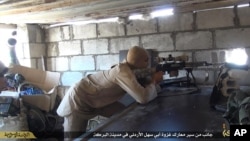Islamic State (IS) militants have been using a new route between Syria and Iraq to ferry supplies since Iraqi Kurdish forces cut off one of IS' crucial links in northern Iraq last month.
The Kurdish forces, known as the Peshmerga and supported by American airstrikes, recaptured the town of Sinjar, cutting off a crucial IS supply route known as Highway 47 between Mosul, Iraq and Raqqa, Syria.
IS has created informal routes through the flat desert of southern Mosul where it uses civilian cars to transfer its fighters and supplies across the border between Iraq and Syria, Kurdish commanders and Iraqi officials told VOA.
VOA Kurdish correspondent Kawa Omar reports that IS militants are using civilian vehicles to move supplies between Raqqa and Mosul. The informal route starts from the small town of Ba’aj, south of Mosul, and continues to the town of Qirwan close to the border with Syria.
A former member of the Iraqi parliament, Qasim Hussein Barjis, said that this new route has become an important lifeline to IS as it has been suffering casualties and damage to its infrastructure from an increase in U.S.-led coalition airstrikes. IS has also faced Russian and Syrian regime strikes.
“The route has been paved by IS from Raqqa to Mosul with the exception of Qirwan town where it has to move across a sandy flat desert,” Barjis told VOA.
The Sinjar operation was an important move toward limiting Islamic State's movement across the border between Iraq and Syria, Kurdish commanders and U.S. officials say.
The new IS route is costlier and more time-consuming compared to Highway 47, but the ease of movement in the flat desert of southern Mosul makes it an attractive alternative to the fighters.
“Unlike Sinjar area, southern Mosul is easy for movement because it is sandy and flat,” said Seydo Husein, a council member in Nineveh, one of Iraq’s 19 governorates.
“We had information that [IS] was working on creating that route before the liberation of Sinjar,” Khalaf al-Adidi, another member of Nineveh Governorate, told VOA.
An Iraqi news website, Niqash, reported that the route is also being used by civilians who trade between Raqqa and Mosul.
“People of the area have opened up small shops on the way and sell water, food, and fuel,” according to a civilian truck driver who was quoted on the website.
Anticipating that future fighting may cut off supply lines, the Islamic State group had already reduced the movement of its trucks through Highway 47 before the Sinjar operation started, according to the VOA correspondent in the area.
IS captured the town of mostly ethnic Yazidis from Iraqi government forces last year. The IS attack on the Yazidi minority led to the first of more than 5,000 U.S. airstrikes against IS.
“We had information that [IS] was working on the construction of a route in south Mosul eight months before the Sinjar operation started,” Haider Shasho, a leading Yazidi commander in Sinjar, told VOA. The Yazidis are a religious and ethnic minority in Iraq and have suffered at the hands of IS since the militants started to gain influence in the Yazidi populated areas.
Shasho expressed concerns about the free movement of the IS fighters along the route.
“IS fighters are moving everything through the route from military supplies to food and fuel,” Shasho said. “I can say that more than 80 percent of the people crossing the Ba’aj border to Syria are [IS] fighters while the rest can be considered civilians empathizing with [IS].”












